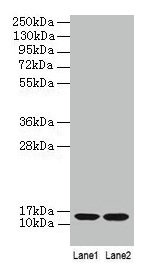![FACS analysis of HeLa cells using GTX34435 beta 2 Microglobulin antibody [B2M/1118]. Blue : Primary antibody Red : Isotype control FACS analysis of HeLa cells using GTX34435 beta 2 Microglobulin antibody [B2M/1118]. Blue : Primary antibody Red : Isotype control](https://www.genetex.com/upload/website/prouct_img/normal/GTX34435/GTX34435_20200115_FACS_192_w_23060801_230.webp)
FACS analysis of HeLa cells using GTX34435 beta 2 Microglobulin antibody [B2M/1118]. Blue : Primary antibody Red : Isotype control
beta 2 Microglobulin antibody [B2M/1118]
GTX34435
ApplicationsFlow Cytometry, ImmunoFluorescence, ImmunoCytoChemistry, ImmunoHistoChemistry, ImmunoHistoChemistry Paraffin
Product group Antibodies
TargetB2M
Overview
- SupplierGeneTex
- Product Namebeta 2 Microglobulin antibody [B2M/1118]
- Delivery Days Customer9
- Application Supplier NoteICC/IF: 1-2microg/ml. IHC-P: 1-2microg/ml for 30 minutes at RT. FACS: 1-2microg/106 cells. *Optimal dilutions/concentrations should be determined by the researcher.Not tested in other applications.
- ApplicationsFlow Cytometry, ImmunoFluorescence, ImmunoCytoChemistry, ImmunoHistoChemistry, ImmunoHistoChemistry Paraffin
- CertificationResearch Use Only
- ClonalityMonoclonal
- Clone IDB2M/1118
- Concentration0.2 mg/ml
- ConjugateUnconjugated
- Gene ID567
- Target nameB2M
- Target descriptionbeta-2-microglobulin
- Target synonymsAMYLD6, IMD43, MHC1D4, beta-2-microglobulin, beta chain of MHC class I molecules, beta-2-microglobin
- HostMouse
- IsotypeIgG1
- Protein IDP61769
- Protein NameBeta-2-microglobulin
- Scientific DescriptionThis gene encodes a serum protein found in association with the major histocompatibility complex (MHC) class I heavy chain on the surface of nearly all nucleated cells. The protein has a predominantly beta-pleated sheet structure that can form amyloid fibrils in some pathological conditions. The encoded antimicrobial protein displays antibacterial activity in amniotic fluid. A mutation in this gene has been shown to result in hypercatabolic hypoproteinemia.[provided by RefSeq, Aug 2014]
- Storage Instruction-20°C or -80°C,2°C to 8°C
- UNSPSC12352203

![ICC/IF analysis of HeLa cells using GTX34435 beta 2 Microglobulin antibody [B2M/1118]. Green : Primary antibody ICC/IF analysis of HeLa cells using GTX34435 beta 2 Microglobulin antibody [B2M/1118]. Green : Primary antibody](https://www.genetex.com/upload/website/prouct_img/normal/GTX34435/GTX34435_20200115_ICC-IF_230_w_23060801_646.webp)
![IHC-P analysis of human cervical ca tissue using GTX34435 beta 2 Microglobulin antibody [B2M/1118]. IHC-P analysis of human cervical ca tissue using GTX34435 beta 2 Microglobulin antibody [B2M/1118].](https://www.genetex.com/upload/website/prouct_img/normal/GTX34435/GTX34435_20200115_IHC-P_408_w_23060801_304.webp)
![IHC-P analysis of human cervical carcinoma tissue using GTX34435 beta 2 Microglobulin antibody [B2M/1118]. IHC-P analysis of human cervical carcinoma tissue using GTX34435 beta 2 Microglobulin antibody [B2M/1118].](https://www.genetex.com/upload/website/prouct_img/normal/GTX34435/GTX34435_20200115_IHC-P_414_w_23060801_190.webp)
![IHC-P analysis of human endometrial carcinoma tissue using GTX34435 beta 2 Microglobulin antibody [B2M/1118]. IHC-P analysis of human endometrial carcinoma tissue using GTX34435 beta 2 Microglobulin antibody [B2M/1118].](https://www.genetex.com/upload/website/prouct_img/normal/GTX34435/GTX34435_20200115_IHC-P_531_w_23060801_468.webp)



![FACS analysis of human peripheral blood using GTX80228 beta 2 microglobulin antibody [B2M-01] (PE).](https://www.genetex.com/upload/website/prouct_img/normal/GTX80228/GTX80228_20191028_FACS_1_w_23061322_155.webp)